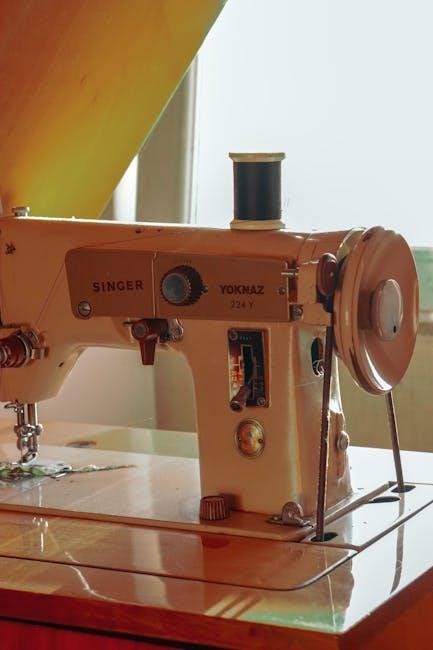The Singer 301A sewing machine is a versatile and durable model, popular among sewists. Its manual provides clear instructions for setup, operation, and maintenance, ensuring optimal use.
1.1. Overview of the Singer 301A Sewing Machine
The Singer 301A sewing machine is a durable, versatile model designed for both beginners and experienced sewists. Known for its slant needle design, it offers a range of stitch options, including straight, zigzag, and decorative patterns. The machine is lightweight yet robust, making it easy to transport and use. Its simple threading system and easy-to-use controls ensure a smooth sewing experience. The Singer 301A is particularly popular among vintage sewing enthusiasts due to its timeless design and reliability. The machine comes with essential accessories like presser feet and a buttonhole attachment, enhancing its functionality. Whether for garment construction, home décor, or repairs, the Singer 301A is a reliable choice. Its comprehensive manual provides detailed guidance, ensuring users can maximize its capabilities and maintain it effectively.


The Singer 301A Manual
The Singer 301A manual is a comprehensive guide providing detailed instructions for setup, operation, and maintenance. It includes troubleshooting tips and accessory information, ensuring optimal machine use.
The Singer 301A manual is a detailed guide that covers every aspect of the sewing machine. It includes step-by-step instructions for setting up the machine, threading, and basic operations. Additionally, the manual provides in-depth information on advanced features such as the buttonhole attachment and stitch selection. Troubleshooting tips and maintenance routines are also included to ensure the machine runs smoothly. The manual is available in both physical and digital formats, with clear illustrations and diagrams to aid understanding. It serves as an essential resource for both novice and experienced users, helping them unlock the full potential of their Singer 301A sewing machine. The comprehensive nature of the manual ensures that users can address any issue and optimize their sewing experience. The Singer 301A manual can be downloaded from various reliable sources. The official Singer website is the primary source, offering a free digital version for registered users. Additionally, websites like ManualsLib, ManualsOnline, and ManualsDir host downloadable PDF versions of the manual. Etsy and eBay often have digital copies available for purchase, though users should verify seller reliability. Some sewing communities and forums may also provide links to download the manual. Always ensure the source is trustworthy to avoid downloading incorrect or incomplete versions. For convenience, Singer’s customer support can also direct users to authorized download links. Downloading the manual is a great way to access instructions anytime, ensuring optimal use of the Singer 301A sewing machine. The Singer 301A manual is designed to provide comprehensive guidance for users. It includes detailed diagrams and step-by-step instructions for setting up and operating the machine. The manual covers basic and advanced features, such as threading, stitch selection, and troubleshooting. It also offers tips for maintaining the machine and resolving common issues. The manual is written in clear, easy-to-understand language, making it accessible for sewists of all skill levels. Key sections include a parts diagram, operation guide, and maintenance schedule. The manual emphasizes safety precautions and best practices for optimal performance. Whether you’re a beginner or an experienced sewer, the Singer 301A manual serves as an essential resource to maximize your sewing experience and ensure longevity of the machine. Setting up the Singer 301A involves unboxing, inspecting, and threading the machine. Familiarize yourself with basic controls and the stitch selector for smooth operation. Unboxing the Singer 301A sewing machine is an exciting first step. Carefully remove the machine from its packaging and inspect for any visible damage. Ensure all accessories, such as the power cord, foot controller, and presser feet, are included. Examine the machine’s exterior for scratches or dents. Plug in the machine and test basic functions, like turning it on and checking the stitch selector. Familiarize yourself with the control panel and the location of key components, such as the spool pins and tension dials. This initial inspection ensures everything is in working order before you start sewing. If any issues are found, consult the manual or contact customer support. Proper setup begins with a thorough check of your machine and its components. Threading the Singer 301A sewing machine is a straightforward process when done correctly. Begin by placing the spool of thread on the spool pin and pull the thread through the tension discs. Guide the thread through the take-up lever, ensuring it is seated properly. Next, insert the thread into the needle bar and pull it gently to create a small loop. Finally, thread the needle and pull the thread to secure it. Always refer to the manual for precise steps, as incorrect threading can lead to poor stitch quality. Keep the thread taut but not overly tight to avoid misalignment. If the thread doesn’t catch, check the tension or ensure the needle is properly inserted. Proper threading ensures smooth operation and consistent stitching. The Singer 301A sewing machine features intuitive controls designed for ease of use. The motor control allows you to adjust sewing speed, while the stitch selector dial enables quick switching between various stitch patterns. The reverse stitch lever is conveniently located for reinforcing seams. The presser foot control ensures even fabric feeding, and the bobbin winder simplifies thread preparation. The machine also includes a convenient handwheel for manual control when precision is needed. Understanding these basic functions is essential for operating the machine effectively. The Singer 301A balances simplicity with versatility, making it suitable for both beginners and experienced sewists. Familiarizing yourself with these controls will enhance your sewing experience and help you unlock the machine’s full potential. Always refer to the manual for detailed guidance on each function. The Singer 301A features a straightforward stitch selector that allows you to choose from a variety of stitch patterns. Located on the front of the machine, the selector dial is easy to operate. Simply turn the dial to the desired stitch, and the machine will adjust accordingly. The stitches include straight, zigzag, and decorative options, making it versatile for different sewing projects. The manual provides a detailed chart of all available stitches and their corresponding dial positions. Always ensure the stitch selector is set correctly before starting to sew. This feature enhances your sewing experience by offering precision and flexibility. By mastering the stitch selector, you can achieve professional-looking results for various fabrics and tasks. Regularly referring to the manual will help you make the most of this feature. The Singer 301A offers advanced features like automatic buttonhole stitching, adjustable stitch length, and a free-arm option for sewing cuffs and sleeves. Its built-in rotary hook ensures smooth fabric flow, while the stitch selector dial provides precise control over 24 stitch patterns. The machine also includes a detachable extension table for larger projects and a reverse stitch lever for reinforcing seams. These features make it ideal for both beginners and experienced sewists, allowing for versatility in sewing, embroidery, and heavy-duty tasks. The Singer 301A’s durability and advanced capabilities ensure high-quality results for various sewing needs. The Singer 301A’s buttonhole attachment is a convenient feature for creating professional-looking buttonholes. To use it, attach the buttonhole foot to the machine and select the desired buttonhole type from the stitch selector. The machine offers round, round velvet, and keyhole buttonhole options. Place the fabric under the foot, align the buttonhole marker with the desired position, and sew. The automatic buttonhole feature ensures consistent stitching and even tension. For best results, use a stabilizing material like interfacing or tear-away backing. Adjust the buttonhole length as needed using the stitch length dial. The Singer 301A’s buttonhole attachment simplifies the process, making it easy to achieve precise, professional-looking results. This feature is especially useful for sewing garments, upholstery, and home decor projects. Proper timing of the rotating hook is essential for smooth stitching on the Singer 301A. The hook must be synchronized with the needle to ensure consistent stitch formation. If the timing is off, it can result in poor stitch quality or even fabric damage. To adjust the hook timing, refer to the manual for specific instructions, as improper adjustments can void the warranty. Use the timing adjustment screw located near the hook assembly, turning it clockwise or counterclockwise as needed. Always test the machine on scrap fabric after adjustments to ensure proper function. Regular maintenance, such as cleaning and oiling, can help maintain optimal timing. If unsure, consult a professional or contact Singer support for assistance. Proper hook timing ensures efficient and professional-looking sewing results. The Singer 301A allows you to tailor your sewing experience to suit your needs. With adjustable stitch length and width, you can customize stitches for various fabrics and projects. The manual provides detailed guidance on how to modify these settings; Additionally, the machine offers a free-arm option, enabling easier sewing of cuffs, sleeves, and other hard-to-reach areas. You can also adjust the presser foot pressure to accommodate different fabric thicknesses. For precise control, the manual explains how to use the handwheel to manually position the needle. These customization options empower you to achieve professional results and adapt the machine to your sewing style. By exploring these features, you can enhance your creativity and efficiency in every project. Proper maintenance ensures the Singer 301A runs smoothly. Regularly clean the machine, oil moving parts, and check for worn components. Troubleshooting common issues like thread jams or uneven stitches can be addressed with simple adjustments. Regular maintenance is essential to keep your Singer 301A sewing machine in optimal condition. Start by cleaning the machine thoroughly, removing dust and lint from the bobbin area and tension discs. Use a soft brush or compressed air for this purpose. Next, oil the moving parts, such as the shuttle hook and gears, using high-quality sewing machine oil to ensure smooth operation. Check for worn or damaged parts, like needles or presser feet, and replace them promptly. Additionally, ensure the machine is stored in a dry, cool place to prevent rust; Finally, refer to the Singer 301A manual for specific maintenance schedules and recommendations tailored to your machine. By following these routine tips, you can extend the life and performance of your sewing machine. The Singer 301A sewing machine, like any mechanical device, may encounter occasional issues. One common problem is thread bunching or jamming, often caused by incorrect threading or tension settings. To resolve this, rethread the machine, ensuring the thread follows the correct path and tension is balanced. Another issue is uneven stitching, which can result from a dull or improperly inserted needle. Replacing the needle with a compatible size and type usually fixes this. If the machine is noisy or vibrating excessively, check for loose parts or insufficient oil. Lubricating the moving components as per the manual can restore smooth operation. Additionally, ensure the bobbin is correctly seated and aligned to prevent sewing inaccuracies. Regular maintenance and adherence to the Singer 301A manual guidelines can help minimize these issues. To ensure the Singer 301A sewing machine operates smoothly and lasts for years, regular maintenance is essential. Always clean the machine after use, removing lint and debris from the bobbin area and tension discs. Lubricate the internal mechanisms as recommended in the manual to prevent friction and wear. Store the machine in a dry, cool place, away from direct sunlight, and cover it to protect from dust. Avoid using excessive force, as this can damage the gears. Use only compatible threads, needles, and accessories to maintain performance. Following the manual’s guidelines for routine upkeep and scheduling professional servicing when needed will help prevent errors and extend the machine’s lifespan. Proper care ensures consistent stitching quality and reliability. The Singer 301A manual highlights essential accessories like presser feet, bobbins, and needles. The Singer 301A manual outlines a variety of compatible presser feet and accessories designed to enhance sewing capabilities. Locating original and replacement parts for the Singer 301A is straightforward, thanks to its popularity among sewists. The Singer 301A manual is supported by a vibrant sewing community, offering forums, social media groups, and local sewing clubs for sharing tips and projects. The Singer 301A manual is well-supported by active online communities and forums dedicated to sewing enthusiasts. Experienced users of the Singer 301A often share valuable tips to enhance your sewing experience. The Singer 301A manual provides a comprehensive guide, ensuring optimal use of the machine. Its detailed instructions and practical advice empower users to achieve professional-level sewing results effortlessly. The Singer 301A manual is an invaluable resource for both novice and experienced sewists. It offers clear, step-by-step guidance, ensuring users can maximize the machine’s capabilities. From basic setup to advanced features, the manual covers every aspect of operation, making it easy to troubleshoot and maintain the machine. Its detailed instructions and diagrams provide confidence, especially for those new to sewing. The manual’s emphasis on routine maintenance and customization options highlights Singer’s commitment to extending the machine’s lifespan and enhancing user creativity. By following the manual, users can unlock the full potential of the Singer 301A, fostering a seamless and enjoyable sewing experience. This comprehensive guide truly serves as the ultimate companion for mastering the Singer 301A sewing machine. The Singer 301A manual serves as a gateway to endless creativity and sewing possibilities. With its detailed guidance, users are empowered to explore various sewing techniques and projects. Whether crafting garments, home decor, or repairs, the manual ensures confidence in every stitch. Encouraging experimentation, it highlights the machine’s versatility and adaptability to different fabrics and designs. By mastering the Singer 301A, sewists can push their creative boundaries and bring unique ideas to life. The manual’s support fosters a sense of accomplishment, making sewing a rewarding and enjoyable hobby. Embrace the Singer 301A as a tool for self-expression and innovation, and let your creativity shine through every project.2.1. What is Included in the Manual?
2.2. Sources to Download the Singer 301A Manual
2.3. Key Features of the Manual

Setting Up Your Singer 301A
3.1. Unboxing and Initial Inspection
3.2. Threading the Machine

3.3. Basic Functions and Controls
3.4. Understanding the Stitch Selector

Advanced Features of the Singer 301A
4.1. Using the Buttonhole Attachment

4.2. Timing the Rotating Hook
4.3. Customizing Your Sewing Experience

Maintenance and Troubleshooting
5.1. Routine Maintenance Tips
5.2. Common Issues and Solutions
5.3. Preventing Errors and Prolonging Machine Life

Accessories and Parts
These enhance functionality and ensure optimal performance.
Original and replacement parts are readily available.6.1. Compatible Presser Feet and Accessories
These include the standard all-purpose foot, zipper foot, and buttonhole attachment.
Additional accessories like bobbins, needles, and thread guides are also recommended.
Using genuine Singer parts ensures optimal performance and longevity of the machine.
Users can explore specialized feet for tasks like quilting, embroidery, or heavy-duty sewing.
These accessories are widely available online or at sewing supply stores.
Investing in the right tools can significantly improve the quality and versatility of your sewing projects.
Always refer to the manual for compatibility guidelines to avoid damaging your machine.6.2. Finding Original and Replacement Parts
The Singer website and authorized dealers offer genuine components, ensuring compatibility and quality;
Online marketplaces like Amazon and eBay also carry a wide range of parts, including rare or discontinued items.
Specialized sewing supply stores often stock replacement needles, bobbins, and belts.
For harder-to-find parts, sewing communities and forums can be invaluable resources.
Always verify the authenticity of parts to ensure proper machine function.
Checking the Singer 301A manual for part numbers can help in identifying the correct replacements.
Remember, using compatible parts is essential for maintaining the machine’s performance and longevity.
Community and Support
Online tutorials, workshops, and user-generated guides provide additional resources to enhance your sewing experience.
The Singer website and community hubs ensure you never sew alone, fostering creativity and troubleshooting.7.1. Online Communities and Forums
These platforms, such as Singer’s official forum and independent sewing groups, offer a wealth of knowledge and resources.
Users can share tips, ask questions, and troubleshoot common issues with the Singer 301A.
Many forums feature detailed discussions on machine setup, stitch selection, and maintenance.
Additionally, enthusiasts often post tutorials, hacks, and creative projects made using the Singer 301A.
These communities provide real-time support and inspiration, helping users maximize their sewing experience.
Whether you’re a novice or an experienced sewer, these forums are invaluable for refining your skills and resolving any challenges.7.2. Tips from Experienced Users
One common recommendation is to always use the correct needle size for your fabric type to ensure smooth stitching.
Regularly cleaning and lubricating the machine is also emphasized to maintain optimal performance.
Some users suggest using a high-quality thread to minimize breakage and improve stitch quality.
Additionally, experienced sewists recommend experimenting with the stitch length and tension settings to achieve the best results for different fabrics.
They also advise keeping a well-organized collection of threads, bobbins, and presser feet for easy access.
These practical tips, shared by seasoned users, can help you get the most out of your Singer 301A and refine your sewing skills over time.8.1. Final Thoughts on the Singer 301A Manual
8.2. Encouragement to Explore and Create
